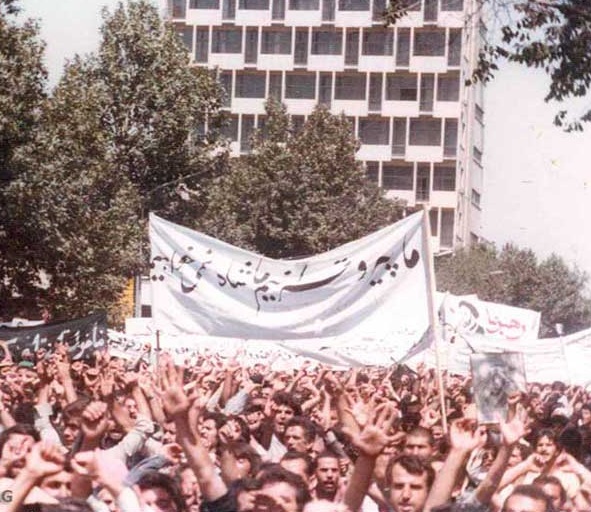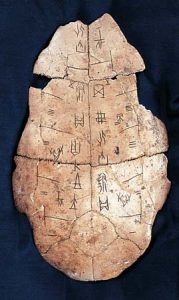The Iranian Revolution led to the overthrow of Mohammad Reza Shah Pahlavi, the latest ruler in the Persian monarchy that had been ruling for 2,500 years. The Grand Ayatollah Ruhollah Khomeini led this revolution, and he eventually ran the Islamic republic that replaced the monarchy after overthrowing the shah.1 The Iranian Revolution transformed Iran’s government and the lives of all its citizens by making religion a key factor in all new laws that they made, as a reaction to the westernizing policies of the shah.
Mohammad Reza Shah Pahlavi was the shah of Iran from 1941 to 1979. He fostered economic development in Iran and also maintained a pro-Western foreign policy. Mohammad Reza’s father, Reza Shah Pahlavi, was an army officer who founded the Pahlavi dynasty in 1925 as he became the ruler of Iran. In 1941 the Soviet Union and Great Britain invaded Iran, forcing Reza Shah into exile, leading to his son Mohammad Reza replacing him in this position. During his time as shah, Mohammad Reza carried out a national development program called the White Revolution with the help of the United States. This White Revolution included many new developments, such as land reform, an expanded road, rail, and air network, and the eradication of diseases such as malaria. This revolution helped the shah gain signifiant domestic support, but he also received political criticism from people who believed the reforms were not doing enough or were not working fast enough to modernize Iran. Along with political criticism, he also received religious criticism from people who thought westernization contradicted Islam.2 This is what would later lead to the shah’s overthrow by Ruhollah Khomeini and his followers.

When Reza Shah came into control in 1925, the status of women changed significantly because he introduced policies that brought change to their lives. He wanted to create a state modeled after Westernism and Europeanism. Because he wanted the Iranian state to be a society with secular ideas and a modern outlook, his policies worked to liberate women. He enacted a Family Protection Act that established family courts to handle divorce and child custody cases. This gave women the right to “divorce on the same grounds as men, and both had to go in court for divorce. For marriage, the minimum age for women was raised from 15 to 18.” In addition to this the shah also “legalized abortion and created family planning and day care centers for women who wanted to work.”3 This act specifically was what angered religious citizens because it went against what they believed in. The implementation of these new policies sparked the beginnings of the well-known Iranian Revolution.

Ruhollah Khomeini, the leader of the Iranian Revolution, was the grandson and son of Shiite religious leaders. He followed in his family’s path to become a Shiite scholar and teacher. He produced a number of writings in Islamic philosophy, law, and ethics, but what made him best known among the people of Iran was his opposition to Mohammad Reza Shah Pahlavi and everything he was doing. In the 1950s he was given the title of an ayatollah, which is a major religious leader among Shiites. By the 1960s, he received the title of grand ayatollah, which made him one of the supreme religious leaders of the Shiite community of Iran. His eventual arrest sparked antigovernment riots, specifically against what the shah was implementing. He stood as the voice for the Shiite community and spoke up about how the shah’s policies contradicted what the Shiite community believed in. In 1964, he was exiled from Iran. He settled in a holy city in Iraq where he continued to speak out against the shah and call for his overthrow and the establishment of an Islamic republic. His influence grew drastically from the mid-1970s. In 1978 he was forced to leave Iraq by the country’s ruler, Saddam Hussein. Khomeini settled in a suburb of Paris where his supporters relayed tape-recorded messages of him speaking to his supporters in Iran, resulting in enormous demonstrations, strikes, and riots.4 These riots would lead to what is today known as the Iranian Revolution and the overthrow of Mohammad Reza Shah Pahlavi and the Persian Monarchy.
In January of 1979, the shah and his family fled Iran on what was officially described as a “vacation”.5 Shortly after this Khomeini returned and took control of the country as the religious leader of the revolution.6 On April 1, he officially declared Iran an Islamic republic.7 The shah and everyone in his regime, met the same fate his father did all those years ago, as they were officially sent into exile. They will never be able to return to the country as long as it remains an Islamic republic. People in the shah’s regime left their families to escape while they still had a chance to leave. Some left easily with their families on “vacations,” but others had to leave on foot through mountains hoping to survive the journey to safety, praying to be reunited with their families one day. Those who did not make it out on time or refused to leave knew they would be arrested or even killed. Many of the people in the regime struggled to find asylum and some even had to move to a few different countries before finally settling. Mohammad Reza Shah Pahlavi also traveled to several different countries before finally receiving asylum in Cairo, Egypt where he passed away in 1980 due to cancer.8
With this new Islamic republic, many new laws were implemented by Khomeini. These laws included requiring women to wear a veil, the banning of alcohol, and the banning of Western music.9 In addition to this, The Family Protection Act was voided.10 The rights that women had gained during the shah’s reign were taken away from them, and things had become even more strict. One law lowered the age of marriage for girls to eight years old, and another gave fathers the right of child custody in the case of a divorce. There was even gender segregation on public transportation on which there were fewer seats even available for women. During the shah’s reign there had been an increase of women in labor force participation, but following these new religious laws, there was a drastic decrease of women in the workforce. Some women of high-ranking positions were even forced to step down because of these new laws.11 Rights of women have improved slightly since then but they still are not like what they used to be. Everything that the shah had worked to change, westernization and liberation of women specifically, had been overturned by the new Islamic Republic.

Recently at the beginning of 2018, demonstrations arose which were organized by the royalists to overthrow the dictatorship in Iran and adopt a new monarchy that supports Westernization. The late shah’s oldest son, Reza Pahlavi, the crown prince of Iran, has expressed his support for these new protests. In an interview the crown prince had accused the Iranian government of being resistant to change, he stated, “Iran needs an overall change. All Iranians want change, it is time for change. The Green Movement in 2009 was a clear reflection that the people of Iran were, and still are, quite unhappy with the Islamic regime and its constitution.”12 He hopes this could possibly lead to him and many others finally being able to return back to their home country. Reza Pahlavi currently lives with his wife and three daughters in Washington, D.C.
The Iranian Revolution changed Iran in many ways, especially in the day-to-day lives of its citizens. Although the lives of men were also affected, the lives of women changed most drastically due to many laws taking their rights away. In addition, the lives of all those who were a part of the shah’s regime and of their families were also transformed. They were forced out of their homes and had to move to new countries and restart their lives. Many of these people are not able to return to Iran still, and some of them may never get the opportunity to go back. With how things are in the country right now, there may be another revolution arising. People are tired of the way things are in the country and want less religion and more modernization. Will this revolution take things back to the way they were during the monarchy? Will the Islamic republic be overthrown? Will women finally be liberated again? Will the royal family finally be able to return to their home? As of now, none of these questions have answers, only time will tell what is in store for Iran’s future.
- Wikipedia, 2018, s.v. “Iranian Revolution.” ↵
- Encyclopaedia Britannica, July 2018, s.v. “Mohammad Reza Shah Pahlavi.” ↵
- Sadia Rafique and Khalid Manzoor Butt, “Position of Women in Iran: An Analysis of Pre and Post Islamic Revolution 1979,” South Asian Studies 32 (2017): 431-439. ↵
- Encyclopaedia Britannica, September 2018, s.v. “Ruhollah Khomeini.” ↵
- Encyclopaedia Britannica, April 2018, s.v. “Iranian Revolution of 1978-79,” by Janet Afary. ↵
- Encyclopaedia Britannica, September 2018, s.v. “Ruhollah Khomeini.” ↵
- Encyclopaedia Britannica, July 2018, s.v. “Mohammad Reza Shah Pahlavi.” ↵
- Encyclopaedia Britannica, July 2018, s.v. “Mohammad Reza Shah Pahlavi.” ↵
- Encyclopaedia Britannica, September 2018, s.v. “Ruhollah Khomeini.” ↵
- Encyclopaedia Britannica, April 2018, s.v. “Iranian Revolution of 1978-79,” by Janet Afary. ↵
- Sadia Rafique and Khalid Manzoor Butt, “Position of Women in Iran: An Analysis of Pre and Post Islamic Revolution 1979,” South Asian Studies 32 (2017): 431-439. ↵
- Aanmoen, Oskar. “Crown Prince Reza Pahlavi Issues New Statement to Iranian Royalists Following Demonstrations.” Royal Central, 23 Apr. 2018, royalcentral.co.uk/international/crown-prince-reza-pahlavi-issues-new-statement-to-iranian-royalists-following-demonstrations-101028. ↵



28 comments
Chelsea Alvarez
As I read this article, I couldn’t help but wonder if the law relied heavily on religion in the United States the way that it might in other countries. I really enjoyed reading about Mohammad Reza and the developments that he brought to Iran as a way to create a more modern country. His implementation of laws that allowed women to divorce their husbands and be eligible for marriage at the age of eighteen versus fifteen really changed the female dynamics of the country. It is scary to see that the Khomeini reversed these laws and now the country is run through a dictatorship.
Engelbert Madrid
In my opinion, I think it is not right for another culture to change the traditions and perspectives of other people’s culture; however, I think it is possible to share our opinions on certain things that we can find morally wrong in our own eyes. For example, modern Western culture accepts and gives the right for women to work and have similar privileges as men, while the Muslim world, led by men, still holds the belief that women are meant to be housekeepers. I hope someday leaders could understand the feelings and opinions of people and what they want.
Nawaf Almarwaie
the Islamic revolution changed the surface of the life in Iran, from normal life to a radical religion life, religious became the regulation in every aspect of the life. Ayatollah Ruhollah Khomeini was the leader of that revolution against Mohammad Reza Shah Pahlavi who his family was forming Iran for long term. Pahlavi was carried national development program called the white revolution which improved the economy, the transportation, the education, and the agriculture. however, the islamic revolution did not help Iran at all, it destroyed the economy and much of the life aspects in order to force people to follow the sick vision about taking control over the whole world under the name of god.
Antonio Coffee
I found this article very interesting because of how it shows that the course of a nation can change so quickly. Under the monarchy, there was a shift towards western culture and there was a lot of civil rights progress being made. Just a few years later and the country had changed so much that all these changes went in the exact opposite direction and were repealed. What is even more interesting is that this was a monarchy that had ruled for over two centuries yet it was taken down in just over a year.
Danielle Slaughter
Unlike some, I am not afraid to say that I am extremely passionate about the situation in Iran. The Ayatollah’s regime is a hideous, backwards one, and how anyone cannot be compelled to call for change is lost on me. Reza Shah’s rule wasn’t perfect – no one’s is, by any means – but it brought progress and freedom that the Iranians hadn’t experienced prior. Women were given the rights to divorce, the rights to abortion, the rights to so many things we take for granted, and to have them taken away within the matter of a few decades? No wonder Iranian women were protesting in the manner they were.
Noah Wesolowski
Interesting how when Reza Shah came into control he pushed for a change in society to mirror how it was in European countries. He tried to modernize by putting in place laws allowing things such as being able to divorce and abortion for women. It surprises me that after he fled the country the began putting in laws for keep women down such as making them wear veils and even making some women step down in their jobs.
Tyler Reynolds
This was an okay article. I think the author either shouldn’t have chosen such broad topic or she should have used more concrete sources for structuring her argument. She did well in mentioning how Iran’s modern Islamic Republic restricted/removed women’s rights and privileges. However, the structure of the article is biased in how it leads readers to believe that Iranians want westernization in their culture. She uses Reza Pahlavi quote as a source without giving someone’s else’s stance on it. Reza Pahlavi, who would obviously have a incentive to claim that Iranians want westernization. If you actually dive into the story, you will see that many, if not all, of the recent protests and riots have been centered on a economic reform. I doubt the people of Iran wish to change their culture, especially within the time span of a few decades.
Overall, I think the author had good intentions it’s just that she didn’t use many differing sources, she was biased herself, and she structured the story to reflect only one point of view. It’s difficult to compress decades of internal tensions and conflict involving numerous economic, political, religious, and cultural factors into a few pages.
Fatima Navarro
Personally, I enjoy political-driven stories and articles maybe because of my major having to do with International Relations and so for. I found this article interesting and a good read, I thoroughly enjoyed knowing more about this story and Iran’s revolution, both points of view before and after. I won’t judge their government, but I do hope in the years to come they’ll be able to move more towards a democracy. Maybe.
Noah Bolhuis
Situations like the one in Iran are often a warning as to what can happen if a government gains too much power. Tyranny can come in many forms, and for many reasons. It is obvious that different peoples in different areas of the world have different values than us. A majority of Americans value a separation of Church and State, but those in Iran, at least in the past, valued their religion more than all else.
Ruben Basaldu
I always find it interesting how we do things compared to other countries. I think that America is a pretty fair country but it is really saddening to see that there are places like Iran who don’t really allow the people living in their country certain rights. I do believe that if the new leadership hadn’t come in that Iran would have been on the right track for a change.